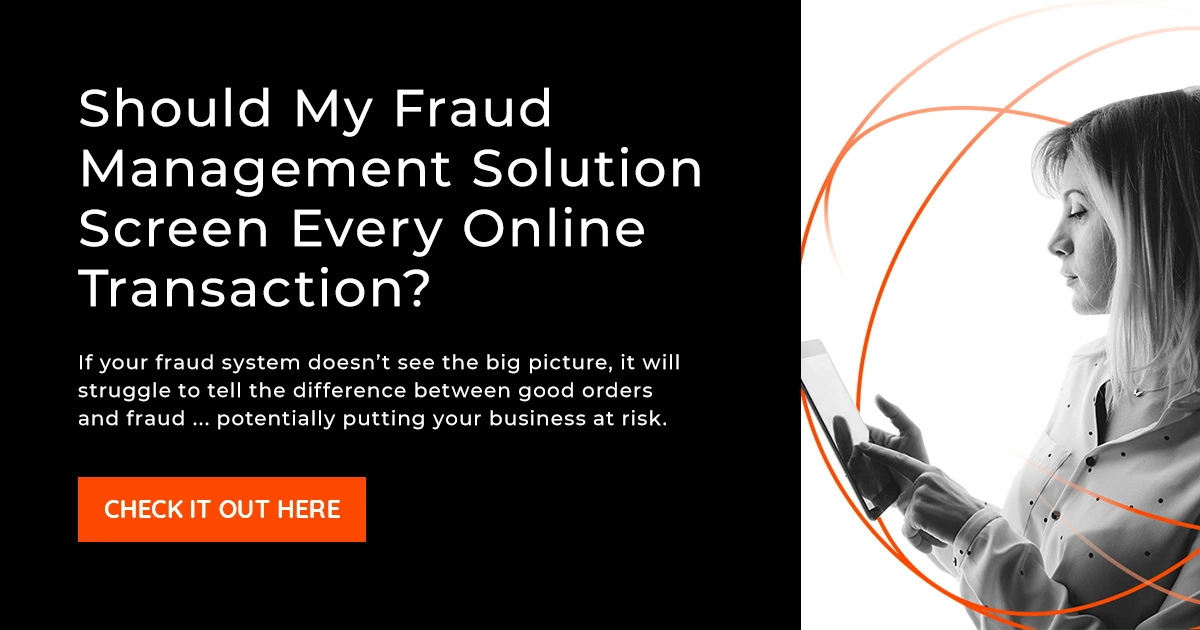Shopify’s Approach to High-Risk Orders and Chargebacks
Shopify is undeniably the gorilla in the ecommerce platform room. And for good reason. With platform sales for 2023 at USD$235.9 billion, Shopify accounts for 10.3% of the global ecommerce platform market.
As appealing as Shopify is to businesses, it has also become even more attractive to fraudsters looking to take advantage of online businesses. When it comes to “high-risk” orders, the stakes are even higher.
Here’s how Shopify helps businesses safely handle high-risk orders and deal with fraud and chargebacks.
“High-risk” is a label that most businesses try to avoid, even when they clearly fall into that category. The reason is simple: High-risk industries, businesses and products are less attractive to credit card issuers and banks, and they’re more attractive to fraudsters.
But, when your ecommerce platform offers tools to safely process high-risk orders, you can breathe a little more easily. Shopify is one of those platforms.
How Shopify Handles High-Risk Orders
High-risk orders are often subject to costly chargebacks because fraudsters target these transactions. Products considered to be high-risk are also high-value, allowing criminals the opportunity to resell and make a hefty profit.
Shopify has developed tools designed to help businesses protect their high-risk orders and prevent chargebacks with the Fraud Protect for Shopify Payments and Shopify Protect solutions.
Fraud Protect for Shopify Payments
Fraud Protect for Shopify Payments protects eligible businesses against fraudulent chargebacks by analyzing and classifying orders as either "protected" or "not protected." Each protected order is subject to a fee that subsequently guarantees payment — if the protected order results in a fraudulent chargeback, the business is not held responsible. Shopify further reimburses the chargeback amount and handles the chargeback dispute.
Businesses have to meet specific criteria to be eligible for Fraud Protect:
- Businesses must be based in the United States.
- They must use Shopify Payments. (Note: If you see a Fraud Protect section on the Shopify Payments page in your Shopify admin, your business is eligible.)
- Only online orders processed through Shopify Payments are eligible for protection.
- Orders that are edited after they are “protected” will be re-evaluated and may warrant an additional fee for protection.
Shopify Protect
Shopify Protect offers chargeback protection from fraud and is free for orders processed through Shop Pay, including orders that use Shop Pay for transactions on other platforms, such as Facebook, Instagram or Google.
Using advanced algorithms to analyze and identify fraudulent orders, Shopify Protect marks orders "protection active" to signify that they are safe to fulfill. This helps businesses approve more orders and ship faster.
If an eligible and protected order receives a fraudulent chargeback, Shopify Protect covers the total order cost and chargeback fee and handles the dispute process.
Orders protected by Shopify Protect include:
- Physical items that require shipping. Digital products and buy online, pick up in store orders are not protected.
- Businesses located in the United States and that have a U.S. Shopify Payments account.
- Orders fulfilled with valid tracking within seven days of the order being placed and in transit to the customer within 10 days.
Note: Any changes to the shipping address after checkout automatically void Shopify Protect coverage on that order.
Fraud Protect and Shopify Protect offer Shopify businesses financial shelter from the cost of chargebacks.
Shopify Chargeback Categories
Shopify has grouped the myriad chargeback reason codes into eight categories and has outlined the documentation needed to increase a business’s chances of winning chargeback disputes.
1. Fraud
Customers will initiate the chargeback process when their credit card has been lost or stolen and unauthorized purchases have been made.
To strengthen their representment case, businesses should submit proof of delivery, like a signature on a delivery form or the identification details of the individual who signed for the delivery. If businesses can demonstrate that the cardholder has or is using the merchandise in question, that evidence should also be submitted.
2. Unrecognized Purchase
If the customer doesn’t recognize the business descriptor or the transaction on their billing statement, they might file a dispute.
Businesses can prevent these chargebacks from being successful by ensuring the company descriptor that displays on card statements is clear and recognizable to customers and by providing proof of the transaction, including order confirmations and email communications.
3. Duplicate Purchases
When a customer is charged twice for the same transaction, they may opt to file a chargeback instead of calling customer service for a refund.
If businesses notice that a customer was double billed for a purchase, they should immediately refund one of the transactions and notify the customer about the mistake.
4. Recurring Subscriptions
Customers may forget they signed up for a recurring subscription and didn’t see the reminder notice (if the business sent one) — or they might think they cancelled their subscription before the next billing cycle.
In this scenario, avoid a chargeback completely by cancelling the subscription immediately. But businesses that pursue representment should provide documentation of their subscription and cancellation policies and proof that the customer agreed to them both. Businesses might also submit proof that customers used or accessed a product after they claimed to have cancelled their subscription.
5. Product Not Received
After claiming they didn’t receive the goods or services they ordered and paid for, customers may file a chargeback on the transaction.
While packages are occasionally lost in transit, businesses can bolster their case by submitting tracking numbers, shipping addresses and proof of delivery (or, in the case of digital goods, proof they were downloaded or accessed). Businesses should provide customers with regular shipping updates, including estimated delivery dates.
6. Product Is Unacceptable
The customer claims the item arrived damaged or defective or the delivered product was not as described.
To win this type of chargeback dispute, businesses should demonstrate the pictures and descriptions online match the actual product, and they should ensure the product is packed to minimize the risk of shipping damage.
7. Credit Not Issued
The customer files a chargeback because they’ve returned the product or cancelled their order, but the business hasn’t issued a credit.
If the cancellation or return was outside a business’s return, refund or exchange policy, the business should submit a clear copy of the policies in their representment documentation.
8. General
This is the catch-all category for chargebacks that don’t fit into any of the other categories.
To successfully defend themselves, businesses should research the specific chargeback reason code with the credit card issuer.
The Shopify platform is also embedded with tools in addition to chargeback protection to highlight orders that may be fraudulent.
How Shopify Identifies Potential Fraud
When Shopify businesses receive an order, the platform automatically scans the transaction for fraud indicators and provides fraud recommendations (for select Shopify plans). Businesses can easily evaluate their Shopify transactions for fraud by following these three straightforward steps.
1. View the fraud analysis
Businesses will want to investigate any order that they believe to be fraudulent or that Shopify has flagged with an exclamation mark. By clicking on the Fraud Analysis link on their order page, businesses can review their order’s fraud indicators, which are marked in three colors:
- Green icons indicate the marked information appears legitimate.
- Red icons mark order information that’s usually associated with fraudulent activity.
- Grey icons flag data that can be used to evaluate the legitimacy of an order.
Shopify Order Indicators | Source: Shopify
Keep in mind that these indicators don’t calculate the likelihood of fraud. Instead, they simply list the legitimate or suspected fraudulent activity Shopify identified during its fraud analysis.
2. View the fraud recommendation
Businesses using Shopify Payments or those on the Shopify Plan or higher will see the fraud indicators plus a fraud recommendation for each of their orders.
This recommendation classifies an order’s chargeback risk as low, medium or high and then flags medium- and high-risk orders on the Orders page. These rankings give businesses added insights that can help them make their transaction decisions.
To develop these recommendations, Shopify applies machine learning algorithms to its historical database of transactions across all Shopify stores and identifies fraud trends and patterns. To help protect businesses against emerging threats, Shopify continuously updates these algorithms based on new fraud information and reports from businesses.
3. Analyze third-party app recommendations
If a business is using a third-party fraud app, that app’s transaction indicators and recommendations display under the Fraud Analysis section. ClearSale’s Shopify app is designed to connect businesses to the ClearSale analysis center.
Pair Shopify’s Tools With a Fraud Prevention Solution
Even with the tools and support available through Shopify, businesses must closely monitor their transactions’ risk indicators and minimize their fraud exposure. Many businesses find that the built-in solutions or free fraud apps just aren’t enough to protect their business against Shopify fraud.
How ClearSale helps prevent fraud and chargebacks
At ClearSale, our comprehensive fraud and chargeback prevention solution is one of the most comprehensive on the market.
- An AI-enabled algorithm leverages trends, intelligence and data gathered from decades of fighting fraud in the most high-risk regions of the world to automatically approve most orders quickly.
- Suspicious orders are flagged for contextual secondary reviews performed by our more than 2,000 fraud analysts who have the experience to recognize some of the hardest-to-spot fraud patterns.
- Data gathered from contextual reviews is leveraged to help our system better distinguish valid transactions from fraud — which increases their approval rates and revenue.
- Our end-to-end chargeback management adds another layer of protection.
For a comprehensive solution to secure customer data, contact ClearSale today to get started.
 Bruno Farinelli
Bruno Farinelli




